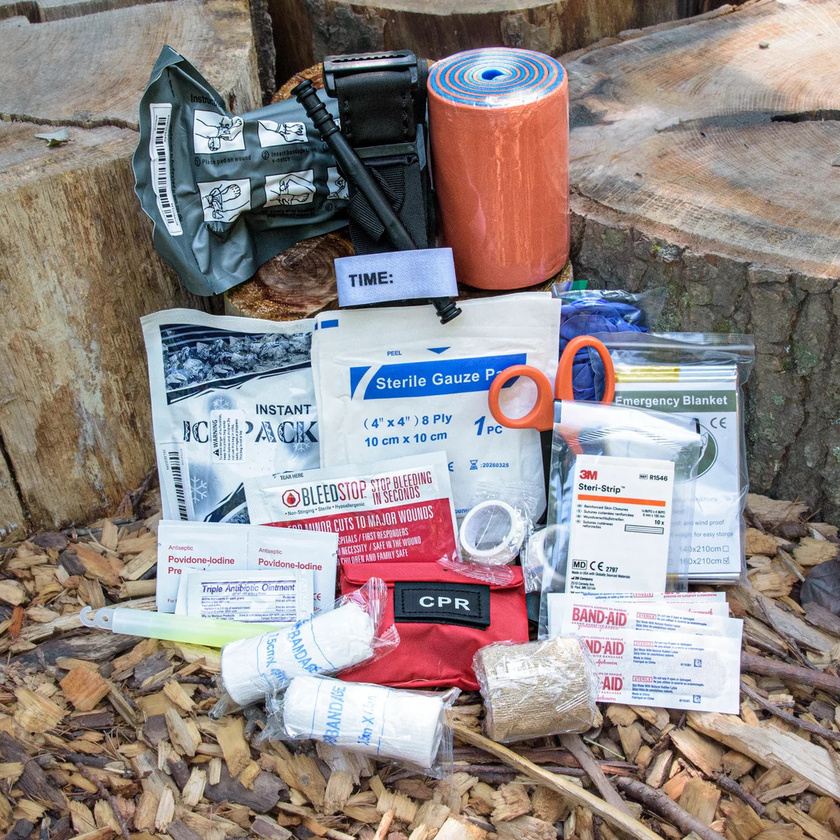When venturing into the wilderness, it is crucial to be prepared for any potential emergencies that may arise. One of the most important tools to carry along is a well-stocked first aid kit. This becomes even more critical when you are in an area without cellular service, where immediate medical assistance may not be readily available. This essay will outline the most important items to include in a wilderness first aid kit.
Please check out my Amazon "influencer" store to find the items I mention below to stock your very own IFAK: Outdoor Roaming / UTAZCO Overland Store
Bandages and Dressings
Bandages and dressings are fundamental components of any first aid kit, serving as the primary line of defense against potential infections and further complications. Their primary function is to protect wounds from exposure to dirt, bacteria, and other harmful elements that could exacerbate the injury or lead to infection.
The variety of sizes and types of bandages and dressings in a first aid kit is crucial to address different kinds of injuries effectively. Adhesive bandages, commonly known as plasters, are perfect for covering small cuts, blisters, or abrasions. They come in various sizes and shapes, allowing for flexibility depending on the wound's location and size.
Sterile gauze pads, on the other hand, are used for larger wounds or those that are bleeding heavily. They are highly absorbent, making them ideal for soaking up and stemming blood flow. Gauze pads can also protect the wound from friction and can be held in place with medical tape or a bandage wrap.
Elastic bandages, also known as compression wraps, serve a dual purpose. They can be used to hold a dressing in place over a larger wound, and they can also provide support and reduce swelling in the case of sprains or strains. The elasticity allows for adjustable tension, ensuring the bandage is as tight or as loose as needed.
Butterfly bandages, also known as wound closure strips, are a specialized type of adhesive bandage. They are narrow adhesive strips that are used to pull the edges of a small wound together, akin to stitches. This promotes faster healing and reduces the likelihood of scarring. They are particularly useful for deep cuts that are small enough not to require professional medical attention but are too large for a standard adhesive bandage.
Bandages and dressings are essential in a first aid kit due to their versatility and wide range of applications. They can be used to cover wounds of various sizes, prevent infections, and stop bleeding, making them indispensable for first aid in the wilderness.
Antiseptic Wipes and Ointments
Cleaning a wound is indeed the first and one of the most crucial steps in wound care. When an injury occurs, especially in a wilderness setting, the wound can easily be contaminated with dirt, debris, and bacteria. If not properly cleaned, these contaminants can lead to infection, which can significantly delay healing and potentially lead to more serious complications.
Antiseptic wipes are an excellent tool for initial wound cleaning. They are soaked in a solution that kills bacteria and other microorganisms, helping to sterilize the wound area. The fact that they are individually packaged ensures that each wipe is sterile and ready for use. This is particularly important in a wilderness setting where maintaining cleanliness can be challenging. The lightweight and compact nature of antiseptic wipes make them easy to carry, even in a small first aid kit.
After cleaning a wound with an antiseptic wipe, applying an antiseptic ointment like Neosporin can provide ongoing protection against infection. Neosporin contains antibiotics that continue to kill bacteria after application, thereby reducing the risk of infection. In addition to its antibacterial properties, Neosporin can also keep the wound moist, which can promote faster healing and reduce the likelihood of scarring.
It's important to note that while antiseptic wipes and ointments are effective at preventing infection, they should be used as part of a comprehensive wound care strategy that also includes protecting the wound with a bandage or dressing. This not only keeps the wound clean but also prevents the antiseptic ointment from being rubbed or washed off.
The process of cleaning a wound and applying antiseptic ointment is a critical part of first aid. These steps help to prevent infection, promote healing, and ensure that a minor injury doesn't turn into a major problem.
Tweezers and Medical Scissors
Tweezers and medical scissors are two essential tools that serve multiple purposes in a wilderness first aid kit.
Tweezers, often overlooked, play a vital role in first aid care, especially in a wilderness setting. They are primarily used to remove foreign objects that may become embedded in the skin. For instance, splinters from trees or plants can easily penetrate the skin during outdoor activities. If left untreated, these can cause discomfort and potentially lead to infection. Tweezers provide a safe and effective way to remove these splinters without causing further damage to the surrounding skin.
In addition to splinters, tweezers can also be used to remove ticks. Ticks are common in many wilderness areas and can carry diseases such as Lyme disease. It's important to remove ticks as soon as possible to reduce the risk of disease transmission. Tweezers can be used to grasp the tick close to the skin's surface and pull it out with steady, even pressure. This method is more effective and safer than trying to remove a tick with your fingers or other tools.
Medical scissors, on the other hand, are a versatile tool in a first aid kit. They are primarily used for cutting medical supplies such as tape or bandages. For instance, if you're applying a bandage or dressing to a wound, you may need to cut it to the appropriate size. Medical scissors, with their sharp, precise blades, make this task easy and efficient.
Moreover, medical scissors can also be used to cut away clothing from around a wound. In some cases, it may be necessary to expose a wound for proper cleaning and dressing. Trying to remove clothing, especially if it's tight or restrictive, can cause unnecessary pain and potentially worsen the injury. Medical scissors allow you to cut the clothing quickly and safely, minimizing discomfort for the injured person.
Tweezers and medical scissors are invaluable tools in a wilderness first aid kit. Their versatility and practicality make them essential for effective first aid care in the great outdoors.
Pain Relievers
Over-the-counter (OTC) pain relievers, such as ibuprofen and acetaminophen, are a critical component of a wilderness first aid kit. They serve multiple purposes, from managing pain associated with injuries or illnesses to reducing fever and inflammation.
Pain management is a crucial aspect of first aid. Injuries, whether minor or severe, often come with varying degrees of pain. OTC pain relievers like ibuprofen and acetaminophen can help alleviate this discomfort. Ibuprofen, a nonsteroidal anti-inflammatory drug (NSAID), works by blocking the body's production of certain natural substances that cause inflammation. This effect helps to decrease swelling, pain, or fever. Acetaminophen, on the other hand, acts primarily in the central nervous system to inhibit pain signals, making it an effective analgesic.
In addition to pain relief, these medications can also help reduce fever. Fever is a common symptom of many illnesses and can be particularly dangerous in a wilderness setting, where the body may already be stressed due to physical exertion or harsh environmental conditions. By reducing fever, these medications can help prevent further complications and make the individual more comfortable.
Furthermore, ibuprofen has anti-inflammatory properties, making it particularly useful for injuries that involve swelling or inflammation, such as sprains or strains. By reducing inflammation, ibuprofen can help improve mobility and decrease pain.
It's important to note that while OTC pain relievers are generally safe for most people, they should be used as directed to avoid potential side effects. For instance, ibuprofen can cause stomach upset, so it's usually recommended to take it with food. Acetaminophen, while gentle on the stomach, can cause liver damage if taken in excess.
OTC pain relievers like ibuprofen and acetaminophen are a valuable addition to a wilderness first aid kit. They can help manage pain, reduce fever, and decrease inflammation, making them a versatile tool in a variety of first aid situations.
Emergency Blanket
An emergency blanket, also known as a space blanket or Mylar blanket, is a unique and potentially lifesaving tool that should be included in every wilderness first aid kit. Originally developed by NASA for space exploration, these blankets are designed to reflect and retain up to 90% of a person's body heat, making them incredibly effective in preventing hypothermia in cold weather conditions.
In a wilderness setting, the risk of exposure to cold weather can be high, especially at night or in higher altitudes. If someone becomes injured or lost, they may be unable to keep moving to generate body heat, and hypothermia can set in quickly. An emergency blanket can be wrapped around the person to trap body heat, helping to maintain their core body temperature until help arrives.
In addition to its heat-retaining properties, an emergency blanket has several other features that make it ideal for a wilderness first aid kit. It's incredibly lightweight and compact, often folding up small enough to fit in a pocket. This makes it easy to carry, even on long hikes or trips where pack weight is a concern.
Furthermore, most emergency blankets are waterproof and windproof, providing additional protection from the elements. They can also be used as a ground cover, a rain shelter, or a signaling device due to their shiny, reflective surface.
It's important to note that while an emergency blanket can significantly increase survival chances in cold weather, it's not a substitute for proper clothing and equipment. Always ensure you're adequately prepared for the weather conditions you expect to encounter.
An emergency blanket is an essential addition to a wilderness first aid kit. Its ability to retain body heat, combined with its lightweight and compact design, makes it an invaluable tool for survival in cold weather conditions.
Allergy Medication
Allergies, whether mild or severe, can pose a significant risk, especially in a wilderness setting where immediate medical help may not be readily available. Therefore, carrying appropriate medication in your first aid kit is crucial.
If you or anyone in your group has known allergies, such as food allergies, insect sting allergies, or medication allergies, it's important to carry the appropriate medication. For severe allergies, this might include an EpiPen (epinephrine autoinjector), which can rapidly counteract anaphylaxis, a potentially life-threatening allergic reaction. It's also essential to ensure that everyone in the group knows how to use these medications in case of an emergency.
Even if no one in your group has known allergies, it's still a good idea to include an antihistamine in your first aid kit. Antihistamines, such as diphenhydramine (Benadryl), can be used to treat minor allergic reactions. These might include reactions to plants, such as poison ivy or poison oak, or insect bites and stings. Symptoms like itching, hives, and swelling can be effectively managed with an antihistamine.
In addition to treating allergic reactions, antihistamines can also be useful for other conditions. For example, they can help alleviate motion sickness or insomnia, making them a versatile addition to your first aid kit.
However, it's important to remember that while antihistamines can manage symptoms of an allergic reaction, they are not a substitute for immediate medical attention in the case of a severe reaction. Always seek professional medical help as soon as possible in these situations.
Carrying appropriate allergy medication, including an antihistamine, is an important part of preparing for a wilderness trip. These medications can help manage allergic reactions and other conditions, potentially preventing a minor issue from becoming a major emergency.
Hand Sanitizer
Maintaining cleanliness, particularly of your hands, is a fundamental aspect of administering first aid. This is especially important in a wilderness setting where the risk of infection can be high due to exposure to dirt, bacteria, and other potential contaminants.
Hands are the primary point of contact when administering first aid, whether you're cleaning a wound, applying a bandage, or performing CPR. If your hands are not clean, you risk introducing bacteria or other pathogens into the wound or the person you're helping, which can lead to infection. This can complicate the healing process and potentially lead to more serious health issues.
Hand sanitizer is an effective solution for maintaining hand hygiene when clean water and soap are not readily available, which is often the case in the wilderness. Most hand sanitizers contain alcohol, which is effective at killing many types of germs, including bacteria and viruses. Using hand sanitizer before and after administering first aid can significantly reduce the risk of infection.
It's important to note that while hand sanitizer is a valuable tool, it's not a substitute for washing hands with soap and water whenever possible. Hand sanitizer may not be as effective when hands are visibly dirty or greasy, and it may not remove harmful chemicals. Therefore, if you have access to clean water and soap, it's best to wash your hands thoroughly for at least 20 seconds.
In addition to using hand sanitizer, wearing disposable gloves can provide an additional layer of protection when administering first aid. Gloves can protect both the person administering first aid and the person receiving it from potential infection.
Keeping your hands clean is a crucial aspect of administering first aid in the wilderness. Hand sanitizer is an effective solution for maintaining hand hygiene when clean water and soap are not available, helping to prevent further infection and ensure effective first aid care.
First Aid Manual
A first aid manual is an indispensable resource in a wilderness first aid kit. It provides detailed instructions and guidance on how to handle a wide range of medical emergencies, from minor injuries like cuts and sprains to more serious conditions like heart attacks or fractures.
First aid manuals typically include step-by-step procedures for various situations, along with illustrations or diagrams to help visualize the process. They cover essential topics such as how to perform CPR, treat burns, deal with allergic reactions, immobilize fractures, and more. This information can be crucial in a wilderness setting, where immediate professional medical help may not be available.
Having a first aid manual is especially important in areas without cellular service. In today's digital age, we often rely on the internet to provide information quickly, including medical advice. However, in remote wilderness areas, cellular service can be unreliable or non-existent, making online resources inaccessible. In such situations, a physical first aid manual can be a lifesaver, providing vital information when it's most needed.
Moreover, in high-stress situations, it's common for people to forget their first aid training. A manual can serve as a valuable refresher, helping to ensure that the correct procedures are followed. It's also a useful tool for those with limited first aid knowledge, providing straightforward guidance in an emergency.
However, it's important to remember that a first aid manual is not a substitute for professional medical advice or treatment. It's designed to provide initial support and stabilize the patient until professional help can be reached.
A first aid manual is a vital component of a wilderness first aid kit. It provides essential guidance on handling various medical emergencies, particularly in areas without cellular service. By following the advice in a first aid manual, you can provide effective first aid and potentially save a life.
Conclusion
A well-stocked first aid kit is a must-have when venturing into the wilderness. It should include bandages and dressings, antiseptic wipes and ointments, tweezers and medical scissors, pain relievers, an emergency blanket, allergy medication, hand sanitizer, and a first aid manual. These items can help manage minor injuries and stabilize more serious conditions until professional medical help can be reached. Remember, the key to effective first aid is not only having the right supplies but also knowing how to use them.


















